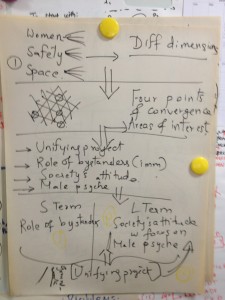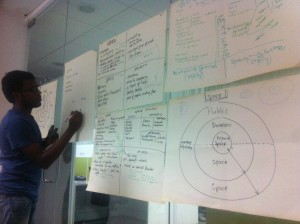It has been one month now, more or less, since we’ve been here. In these last three to four weeks we have been breaking our brains over what we are researching. What exactly do we want to work on? How do we define these aspects and, how can we formulate our research question? Also, we had online meetings with team Amsterdam to see how they are progressing and Sruthi gave us a nice introductory lecture on India and its society. We will start off with the progress of our research question.
We were aware of the complexity of our problem, sort of. I like to compare it to taking a spoon of curry and we have to distinguish between flavors. The first thing we did to find the research question was blowing up the sentence ‘women‘s safety in public space‘. We took the spoon of curry apart and checked which spices we could see. What do we define as women and what kind of women are there? What is the definition of safety, for whom and why? What kind of spaces are there, which ones are problematic and what can we use from this? We can tell you now, these questions are more difficult than meets the eye, especially in a country like India… So many spices!
We found out that the subject we are working on has many variables. If separated, flavors might taste different than combined. The taste palette, or the width of our problem is extremely complex and intertwined. Reading in on the Indian culture doesn not go overnight, it takes a lot of work and good guidance. Maybe we can start by saying that we are not going to solve this problem on our own? Either way, all the work that we do for the sake of this subject is a step in the good direction and that feels great.
After we figured out how broad each of our aspects were, how wide the spectra are, we started to think about what interests us the most. From this soul seeking on our interest came three main approaches to this subject. Short term: a project or product that can be realized within a short span of time. Long term: the longer term goals that the short term project feeds in. Unifying project: looking at the already existing projects and find ways to connect and unify them. The reason for these three aspects is as follows.
The problem we are facing is incredibly broad and deeply rooted. It does not stop simply at looking at busses or city-squares. The problem is deeply rooted in society and in the attitude of the citizens. It has been around for so long that we figured out that one single action wouldn’t make a big change. With a relatively small action we wouldn’t get to the core of the problem, thus a long term project is required. To really do this, we would have to research the norms and values of the society in general. How do people see each other and in what way do people respect each other? Why do they do what they do, in what ways? Only by doing this we could figure out where we should seek the ‘solution’. Although this seems like a very nice plan it is a little ambitious. Not only because the half of our team is non-Indian and knows little about the culture and traditions, but also because of the many variables at work. Last but not least, there is our limited timeframe in which we have to do something.
Short termed action seems to be a feasible goal within the time we have here. This is something we can finish. Ideally, the short term action feeds into a greater long term goal. How we are realizing this is not yet clear to us yet.
Then we have the unifying part. This part comes from the idea that there are already many initiatives in this field. There are already many projects about safety, or more specific, on women’s safety. Not only in India but also elsewhere in the world. All these projects would, first of all, be useful for us to study and see how they handle different situations and how we can get inspired by their visions and ideas. Next to this ‘fundamental’ research, we are looking for ways to interconnect these different initiatives to join forces and become stronger as unity. The main focus though, lays on the short term direct action. Different roles within our frame are: victims, bystanders, perpetrators, institutions, institution-representatives and media.

Our calls with the MediaLAB Amsterdam gave us a good insight in how our situation differs from the current situation in Amsterdam. Although we started off with the same ‘question’ or problem set, we immediately saw that team Amsterdam is going in another direction than we are. Amsterdam is relatively safe. The focus of their project, as for now, is more in the perceiving of safety. As for us, it is a combination of subjective safety (if you feel save) and objective safety (if it is safe).
One overlapping aspect we found out is that different groups of people perceive safety in different ways. Lets say that a student, born and raised in Amsterdam, feels relatively safe on the streets of Amsterdam. He or she knows where to go or where not to go. A tourist in Amsterdam might get another feeling; in a new city where you know nothing about anything that is going on there, you might feel less safe. In our case we didn’t focus much on the divide of locals or tourists, more on the social status and cultural hierarchy. How do people from low caste and low class perceive safety compared to high caste and high class?
In this blogpost we can’t provide you with a definite research question yet, unfortunately. The field of research is still too broad for us to be focussing already on something particular. For that, we can provide you with a focus of the research we are working on right now. How can we make a product/service to get the bystanders to be more alert or assertive? How can we influence the attitude of the Indian society to be more respectful towards women (in the long term)? How can we combine the work that is already been done to make a powerful unit?
Any suggestion about concepts, existing projects or insight on this matter are more than welcome. In the meantime, we’ll keep busy!








